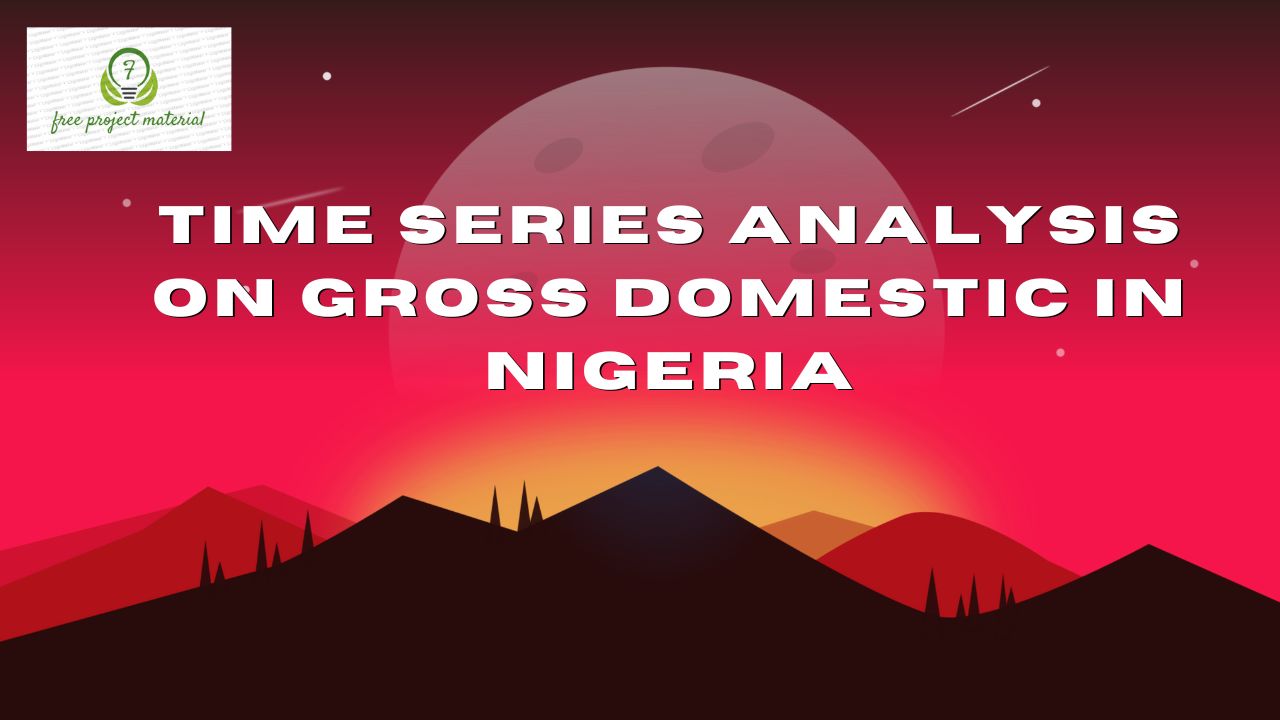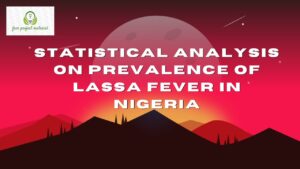ABSTRACT
This study is carried out to examine the rate of Nigeria economic growth. The country GDP is used as a proxy for economic growth. Data on quarterly GDP from 2010 – 2019 was obtained from Central Bank of Nigeria. Ratio-to-trend and least square method was used to analyze the data. Results of the study shows that the GDP is composed of both seasonal variation and trend. The result of the seasonal index revealed that, the GDP is negatively affected in first half of every year and positively affected in second half of the year. Results of trend equation revealed that, the GDP increases on average by 53billion naira per quarter. It was found that the trend is significant at 5% level of significance. The study concluded that, Nigeria economic growth is affected by seasonal variation and regardless the effect of the season, there has been an increase in the economic growth of the country. It was recommended that, Nigeria government should promote local businesses so as to enhance the country international trade, they should do more in diversifying the economy by promoting other sectors such as agriculture and also other concern agencies should investigate the causes of seasonal effect on the growth of the economy.
TABLE OF CONTENT
Title Page – – – – – – – – i
Certification – – – – – – – ii
Dedication – – – – – – – – iii
Acknowledgements – – – – – – iv
Abstract – – – – – – – – v
Table of contents – – – – – – – v-viii
CHAPTER ONE: INTRODUCTION
1.1 Preliminary – – – – – – – 1-3
1.2 Statement of Problem – – – – – 4-5
1.3 Objectives of the Study – – – – – 5
1.4 Statement of Hypothesis – – – – – 6
1.5 Assumption of the Study – – – – – 6
1.6 Significance of the Study – – – – – 6-7
1.7 scope of the study – – – – – – 7
1.8 Definition of Terms – – – – – 7-8
CHAPTER TWO: REVIEW OF RELATED LITERATURE
2.1 Introduction – – – – – – – 9
2.2 Literature Review – – – – – – 9
2.2.1 Economic Growth and GDP – – – – 9-11
2.2.2 Nigeria Economic Growth – – – – 12-19
CHAPTER THREE: RESEARCH DESIGN AND METHODOLOGY
3.1 Introduction – – – – – – – 20
3.2 Design of the Study – – – – – 20
3.3 Population of the Study – – – – – 21
3.4 Sampling Procedure – – – – – 21
3.5 The Sample- – – – – – – 21
3.6 Data Collection – – – – – – 22
3.7 Data Analysis Techniques and Presentation – – 22
3.8 Data Preparation – – – – – – 22
CHAPTER FOUR: DATA ANALYSIS, RESULTS, AND INTERPRETATION
4.1 Introduction – – – – – – – 23
4.2 Data Presentation – – – – – – 23
4.3 Data Analysis – – – – – – 23
4.3.1 Moving Average Method – – – – – 23-28
4.3.2 Least Square Method – – – – – 28-31
4.3.3 Trend Estimation – – – – – – 31-33
4.4 Interpretation of Results – – – – – 33-34
CHAPTER FIVE: SUMMARY AND CONCLUSION
5.1 Introduction – – – – – – – 35
5.2 Discussion of Findings – – – – – 35-36
5.3 Summary – – – – – – – 36
5.4 Conclusion – – – – – – – 37
5.5 Recommendations – – – – – – 37-38
References
Appendix
CHAPTER ONE
INTRODUCTION
1.1 Preliminary
Economic growth remains one of the fundamental objectives of macroeconomic policy in which strong efforts are being made by countries all over the world to accelerate its pace (Uzoigwe, 2007). Economic growth can be defined as a sustained increase in per capita national output or net national product over a long period of time. Economic growth can also be seen as the quantitative increase in the monetary value of goods and services produced in an economy within a given year (Bonga, 2018).
In African countries, the primary focus is to have high and sustainable economic growth. This high and sustainable economic growth is necessary, for widening development, expanding scope for individuals to be productive and creative. Economic growth makes it possible for country as well as individual to achieve other important objectives, this include sparing people collectively from drudgery and poverty (Anyanwu, 2014). Additionally, it generates useful resources to support health care, education and other Millennium Development Goals (MDGs) to which the countries have committed themselves.
Generally, it is believed that the economic development of any country is dependent upon the quality and quantity of its resources (renewable and non-renewable), the technology and the efficiency of resources utilization in both production and consumption processes (Uzoigwe, 2007). However, generating a high and sustainable economic growth in resources-rich developing countries remains one of the most pressing challenges to global development (Anyawu, 2014).
Despite being the largest oil producer in Africa, Nigeria has struggled to translate its natural resources into prosperity, development and rising living standard (Bukola, 2018). In spite of the numerous plans, policy frameworks and reforms, economic growth remains epileptic, lacking sustained or consistent growth and subjected to the vagaries of crude oil and gas prices. Each planned programme, vision and reforms generates much hopes but actually produces little impact while mismanagement, corruption and poor performance continue to hinder economic management (Samson, 2014). While the majority of Nigerians reels under the yokes of poverty, disease and misery, the ruling elite has not demonstrated serious commitment, discipline and sacrifice in driving growth and progress. Economic inequality remains deep as the number of people living in poverty increased from 69 million in 2004 to 112 million in 2010, despite an average economic growth of more than 7% (Emmanual, 2017).
Nigeria is still one of the world’s economically backward countries; actually, Nigeria is too rich to be poor. Therefore, a positive economic growth is desirable in any country. It is for this reason that economic growth is a metric that need to be watched and followed the most. Thus, this study sought to investigate the trend of economic growth in Nigeria.
1.2 Statement of Problem
A high and sustainable economic growth mainly depends on ability of a nation to invest efficiently and prudently make use of the resources at its disposal. Despite being the largest oil producer in Africa, Nigeria has struggled to translate its natural resource into prosperity, development and raising living standard (Bukola, 2018). In spite of the numerous plans, policy frameworks and reforms, economic growth remains epileptic, lacking sustained or consistent growth and over depending on petroleum products. Each plan, programme, vision and reforms generates much hopes but actually produces little impact while mismanagement and poor performance continue to undermind economic growth (Samson, 2014).
In recent years, several programmes have been initiated by government which aimed at improving the productive capacity of the Nigerian economy. Some of the programmes are: National Poverty Eradication Programme (NAPEP), National Economic Empowerment and Development Strategies (NEEDS), and Structural Adjustment Programmes (SAP). In order to assess the effectiveness of the various intervention, there is need to investigate the rate of the economic growth. Hence, this study is conducted to assess the rate of Nigeria economic growth.
1.3 Objectives of the Study
The objectives of this study are
- To determine the trend of GDP in Nigeria.
- To fit the least squares equation to GDP in Nigeria.
- To predict the future GDP in Nigeria.
- To examine the seasonal effect on GDP in Nigeria.
1.4 Statement of Hypothesis
H0: The model is not significant.
H1: The model is significant.
1.5 Assumption of the Study
- GDP is a good measure of economic growth.
- Economic growth of any country is affected by many macro-economic factors.
- The range of data used in the study is sufficient to understand the situation of economic growth in Nigeria.
1.6 Significance of the Study
(i) This study will provide useful information on the economic growth in Nigeria which will help the government and other policy makers to make appropriate decision and implement of favourable policy for the betterment economy of the country.
(ii) Future researchers will also find this work very interesting as it can be used as reference materials that will guide them while carrying out research on related or the same topic.
(iii) This study will also contribute to previous studies which have examined the economic growth rate in Nigeria.
1.7 Scope of the study
This study examine the rate of growth in Nigeria using GDP of the Nigeria as a measure of economic growth. The study covers quarterly GDP of Nigeria from 2010-2019.
1.8 Definition of Terms
Gross Domestic Product (GDP): This is the total market value of the goods and services produced by Nigeria economy during a specified period of time.
Economic Growth: This is the process by which a nation’s wealth increase over time.
Trend: This is a general direction in which the Nigeria GDP is moving.
Seasonality: This is a characteristic of the quarterly GDP in which it experiences regular and predictable changes every year.

